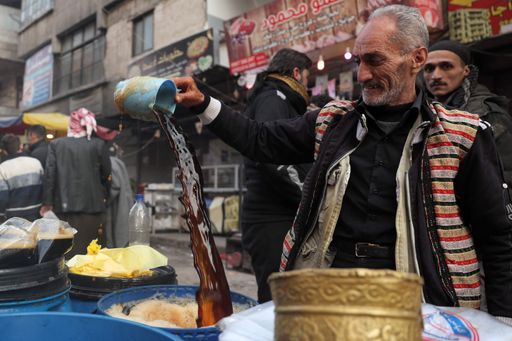Syria is going to revalue its national currency by removing the last two zeros from banknotes later this year.
The Syrian pound lost 99 percent of its value against the US dollar over the 14 years of civil war when deposed dictator Bashar al Assad ravaged the economy and destroyed millions of livelihoods to quell a national uprising against his Baathist regime.
One US dollar equalled 50 Syrian pounds before the start of the civil war in 2011. The excessive printing of money, coupled with a complete breakdown of economic activity, crashed the currency, resulting in one US dollar now equalling roughly 13,000 Syrian pounds.
A lack of digital payment infrastructure means ordinary Syrians are forced to carry bundles of currency notes in sacks weighing several kilos while going for weekly grocery runs.
The 5,000-pound note is the largest denomination currently in circulation. Dropping the last two zeroes from the note’s value will mean 50 pounds will buy the same quantity of goods that currently costs 5,000 pounds.
The exercise may seem cosmetic at first, but it is likely to have far-reaching consequences.

What will the revaluation achieve?
Analysts say the revaluation exercise will achieve three broad objectives.
One, it will reduce the hassle of cash handling and storage. It will make daily transactions easier and save countless man-hours, which are otherwise wasted on counting, transporting, and storing nearly worthless pieces of paper that sometimes weigh several kilos.
Two, the exercise will bring the stashed-away cash back to the formal economy. Reports say up to 40 trillion Syrian pounds currently exist outside of the formal financial system. The revaluation exercise will force cash hoarders into bringing large sums of money to bank counters to exchange with new notes.
Under the Baathist regime, crony capitalists like Rami Makhlouf, a cousin of Assad, amassed wealth through monopolies in real estate, banking, and other sectors, while the broader population faced deepening poverty.
Moreover, illicit activities, including the Captagon drug trade, smuggling, and extortion, became financial lifelines for the Assad regime, further entrenching a war economy that rewarded loyalists and warlords.
Necessitating a change in currency notes will bring back large chunks of black money into the formal banking channels. The revaluation exercise will let the new government trace the money that currently remains unaccounted for, thus enabling Damascus to devise better tax policies and improve its fiscal affairs.
Lastly, the issuance of new notes will mark a clean break from the Assad regime.
The images of Assad and his father appear on bills of many denominations. Authorities hope that doing away with Assad-era notes will help heal the wounds of the Syrian nation, which lost hundreds of thousands of people to state-backed kidnappings, torture, and killings under the Baathist regime.

The path ahead
Decades of kleptocratic rule and a brutal civil war left Syria’s economy in tatters, with the GDP plummeting to a record low of $21 billion and more than 90 percent of Syrians dragged below the poverty line. Runaway inflation ruined the purchasing power of ordinary Syrians.
Syria was subject to harsh sanctions that limited its ability to trade with the world. All banks, businesses and individuals that provided funding or assistance to the Assad regime were cast out of the global financial system, effectively pushing the entire country into complete economic isolation.
Exports remained suspended for years, choking the main source of foreign exchange that determines the strength of a currency and protects it from runaway inflation.
The transitional government of President Ahmed al Sharaa, whose opposition forces took over the war-battered country in a lightning-quick offensive at the end of 2024, has concentrated its efforts on stabilising the economy, signalling a potential turning point for a country long plagued by corruption and conflict.
Regional powers like Türkiye are also extending generous help for large-scale infrastructure projects, while international financial institutions have shown willingness to play their part in bringing the Syrian economy back from the dead.
Once the Syrian monetary authorities formally announce the redenomination of the national currency, they will phase out the existing currency notes over a months-long transition period. Digital systems, accounting ledgers, foreign loans, and contracts will be updated to reflect the new denominations.
Meanwhile, fresh currency, likely to be printed by Russian state-owned money-printing firm Goznak, will be pumped into the economy over the transition period as businesses recalculate input prices, wages, and debts to avoid confusion.
Once the transition period is over, the central bank will try to maintain the value of the Syrian pound in the currency market by buying or selling government bonds.
Who else did currency revaluations?
Nations have conducted currency revaluations, with varying results. One notable success is China's 2005 revaluation of the yuan (renminbi).
Facing pressure from trading partners over its undervalued currency, China adjusted the yuan's peg to the dollar by 2.1 percent upward, followed by gradual appreciation.
This helped control inflation, boosted domestic consumption, and integrated China deeper into global trade without major disruptions.
Another example is Kuwait's dinar revaluation post-1990 Gulf War. After Iraq's invasion devalued the currency through counterfeit flooding, Kuwait reintroduced a strengthened dinar in 1991, backed by oil reserves.
This restored confidence, and the dinar remains one of the world's strongest currencies today.
As for failed attempts at currency revaluations, Russia’s 1998 exercise that slashed three zeros from currency notes amid hyperinflation tops the list. The revaluation proved futile, with the currency collapsing under economic pressures after the fall of the Soviet Union.
Zimbabwe's multiple revaluations from 2006 to 2009 removed up to 25 zeros from its currency notes. Yet these repeated attempts to stabilise the currency failed due to unchecked money printing, culminating in hyperinflation rates of billions of percentage points.



















